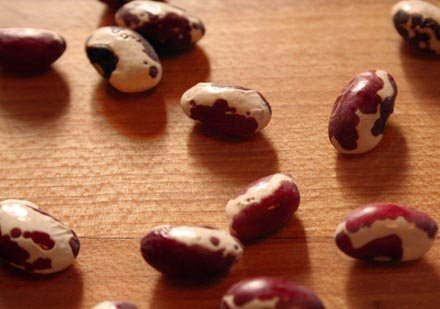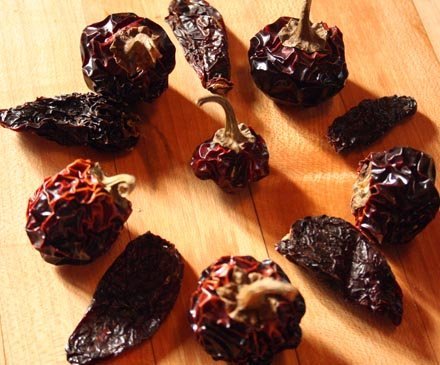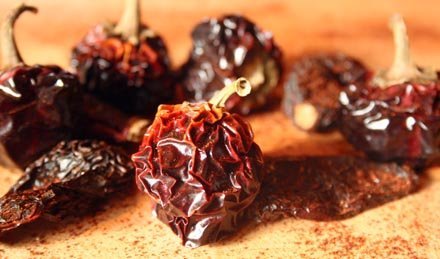
(Vegetarian, vegan, gluten-free)
I realize that it’s the middle of summer. From where I stand it’s a humid 85 degrees and climbing, and I know that in Tucson, where I have at least two readers, it’s 106 degrees at 10:00 at night. Not exactly chili weather, true.
But I’ve been asked to contribute a bean recipe to a magazine article, and though the article won’t run until October all recipes were due this week, so this is what we’re having tonight. And anyway, I can’t think of a better showcase for the little jewel called Anasazi Cave Bean.
This bean is the reason I’m obsessed with seeds.
Imagine it. A cave, nearly hidden, high inside a glacier-carved, wind-sanded canyon wall in New Mexico. Outside the cave, the sun has scorched everything to red; inside it’s cool, dark, and quiet. The only sounds are those you and your fellow archeologists make as you gently scrape the sugar-dusted sandstone walls, each echo stirring up memories that can’t possibly belong to you, of times when ice sheets groaned their way across the belly of this canyon.

On the underside of a ledge protruding from a dusty wall, your knuckles rake gravel and clay and then, something more deliberate. Its purposeful shape catches your senses, and you gently pull it out. It’s a tiny pot, formed from the clay of these very walls.
It’s sealed tightly, impossibly, with tar. Later, you’ll learn that it’s pine pitch, but for now you struggle to pry the beaded, rocklike substance off. It must have been here a very long time.
At last and with a weary, crackling sound, the tar gives and the pot’s lid slides sideways. Three pebbles tumble into your open palm. They are an oblong shape, speckled with white and mahogany spots, and unlike any of the stones you’ve encountered in this desert terrain. But no, not pebbles. They’re seeds. Bean seeds.
The seed found in that clay pot was ferried to a lab, where carbon dating revealed that it had been sitting in that high, dry enclave in the desert for nearly 1,500 years. The seed’s finder, always pushing the envelope, hid one in her pocket. Later, she did exactly what this bean’s original cultivators did, the only thing there was to do: she planted it.
It grew.
And from this leap of faith came the seed crop that today I’m nurturing in my garden, and the seeds that we’re having in our chili sans carne.
This is one version of how the Anasazi cave bean was rescued as it dangled from the bridge of extinction. Some believe that this is merely apocryphal, but I’ve always believed it was true. Seeds are like that.

And now it seems that there’s reason for belief.
Recently, news sources carried a story about a 2,000-year-old date palm seed. Recovered from the ancient Jewish fortress of Masada near the Dead Sea, it has become the oldest seed in the world to have germinated successfully.
The seed was found with two others during archeological excavations in the 1960s. Radiocarbon dating showed that the seeds were formed sometime between 206BC and AD24. To put this in perspective, that was just before the Romans laid siege to Masada in AD72.
The seed was stored for two decades, and recently, as part of a science experiment of sorts, it was planted. It’s now a fledging tree, just four inches tall and sporting five palmate leaves (a sixth was removed for DNA testing).
I don’t really have words to convey the magnitude of such things, but maybe I don’t need them. Perhaps you’re as stunned and awestruck, with a rebellious sort of hope that’s attached to nothing in particular, stirring inside of you. Probably this rebellion is just a quiet empathy. How determined must a life force be, to hang on, hang on, across geologic periods?
If you need to know more, here’s a link to the story as reported in the Los Angeles Times, complete with photos of the date palm seedling:
And thank you, Gilda, a reader from Canada (who has been cooking beans for years and who once received a personal letter from MK Fisher). Gilda sent me this link to the story as it ran in The Independent (a newspaper that Simon has a fondness for):

The recipe:
There are lots of stories about the Anasazi people, those high-cliff cave dwelling people from New Mexico and Arizona, and those stories are fodder for my speculation about the beans. Could those beans have been hidden away from scavengers, or was someone planning to come back for them after the winter season? Did they have some other, symbolic meaning, being preserved in a pot and sealed so deliberately? An offering, even?
It’s impossible to know, and impossible for me not to wonder as I’m eating my chili, or running my fingers through any of these heirloom beans, these miraculous, tenacious survivors of epochs. No wonder I love beans.
Practically speaking, the Anasazi bean is meatier than a lot of beans, and dry (perhaps it took on the qualities of its climate). Though they are a gorgeous red-jewel speckled white, when they are cooked they fade to an even reddish-brown. The pot liquor (the cooking water) doesn’t yield much information about the bean’s taste – it’s a mild, earthy smelling liquid that doesn’t match up to the bean’s sturdy presence. This bean doesn’t get lost in the riot of flavors that go into chili, and since it also holds its shape, it’s an ideal bean.
This mildly spicy chili looks like it has many ingredients, but a well-stocked spice bin is the key to transforming any quick and easy dish into something noteworthy. The secret here is to layer flavors by combining fresh and dried chilis for a rich and complex flavor.

Another tip for added flavor – sauté the seasoning in the oil, along with the vegetables, rather than simply stirring it in later. The hot oil brings out the brightest flavors, a trick I learned from Indian cooking.
Quick Chili Sans Carne, with Anasazi Cave Beans
3 tablespoons olive oil
½ large white onion, diced
6 cloves garlic, minced
1 red bell pepper
½ fresh jalapeno pepper, seeds removed
1 pound Match ground pork meat alternative (note; if you use animal protein in this recipe instead, you’ll need less cooking oil)
2 tablespoons mild packaged chili seasoning mix
2 teaspoons ground coriander
1 teaspoon sweet paprika
1 teaspoon Mexican oregano
½ teaspoon whole dried chipotles, ground
2 tablespoons ground cumin
2 ½ cups red beans, cooked (about 15 ounces)
1 28 ounce can diced tomatoes
12 ounces tomato puree
½ bottle light bodied beer, like Corona
1 teaspoon salt
4 shakes of liquid smoke

In large stock pot over medium heat, heat oil and then sauté onion, garlic, bell and jalapeno pepper for two minutes. Stir in chili seasoning, coriander, cumin, paprika, oregano and ground dried chipotles. Let cook for two minutes longer. Add Match vegetarian pork sausage and stir well. Cook for three minutes more, stirring occasionally.
Add beans, diced tomatoes, tomato puree and beer. Stir and bring to a simmer. Reduce heat and let cook for 10 minutes. Add salt and liquid smoke and let simmer for another 10 minutes.
